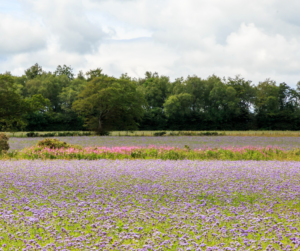Let’s talk cover crops
28th May 2023
David Miller, farm manager at Wheatsheaf Farming near Basingstoke, was an early adopter of cover cropping. With 13 years of experience behind him, he shared his learnings on successful cover crop establishment with fellow farmers during a webinar led by Severn Trent.
Mr Miller explained that Wheatsheaf Farming’s use of cover crops started in 2010 when the business looked for alternatives to conventional farming methods for their arable production.
Introducing cover crops
Mr Miller explained: “Firstly we put in half a field of crimson clover before spring barley. Two years later we could still see the line in the field where we did the cover crop; so we knew there was something in it that was good for the soil.”
In the years since, both availability and knowledge of seed options has grown across the industry. Wheatsheaf has subsequently adapted its selection, learning along the way what works best, said Mr Miller.
“We found early on that if you put in a big multi-species crop, about three grow. That’s all to do with your soil having been mono-cropped for years, so it is not ready to accept all of these new species,” he said.
“It’s a case of persevering. We never thought we’d go so far as having sunflowers in late autumn! We’re now growing an eight-way cover crop mix quite successfully,” he said. “This contains phacelia, buckwheat, sunflower, golden pleasure, vetch, lupins, beans, clover, and radish.”
Learning which cover crops work
The business has come up with some fundamental rules for their cover cropping. The decision not to incorporate brassicas or cereals is central to this, Mr Miller said.
“Brassicas don’t associate with mycorrhizal fungi. We’ve found they can enhance clubroot where we’ve got oilseed rape in a rotation, and they’re a harbour for slugs. We’ve also seen cereals result in volunteers, so we’re trying to only use the broad-leaved legume type mixes.”
Wheatsheaf has carried out a number of cover cropping trials over the last few years, enabling them to objectively measure and assess the impacts for the farm’s yields and on-farm.
Nitrates
“For the last seven years we’ve been testing the nitrate levels in water captured in porous pots under cover crops and control plots of stubble,” said Mr Miller.
“We’ve found that the cover crops have very little nitrates compared to the stubble. We’re definitely catching nitrates in the crop and stopping leaching through the soil profile into groundwater.”
A focus on margin over yield has also led to a decrease in inorganic inputs. “We’ve cut our use of nitrogen by 25% across the board,” added Mr. Miller. “We don’t apply more than 180kg N/ha to any crop and we’re trying to bring that down further through using foliar nitrogen.”
Soil organic matter
The farm has limited access to organic manure so relies on cover crops to raise soil organic matter. Mr Miller explains he is pleased with recent analysis results.
“Across the whole farm we’ve taken the organic matter levels up by about 0.75%, since we started cover cropping,” he said. “We’re now running 4-5% organic matter on average.”
Biodiversity
Using insect pitfall traps and worm counts, the Wheatsheaf team have been able to identify a pattern of increasing biodiversity.
“Worms are a good proxy for soil health and we’ve seen our numbers increase dramatically, comparing cover cropped land to stubble,” said Mr Miller. “There’s a wider range of worm species too.
“Our agronomist is really keen on worm sampling. When he tested the soil from a worm cast, it came back with P and K indices of 4 where the rest of the field had indices of 3 and 2+. There’s a big difference once soil starts to pass through the worm.”
Insect pitfall traps have found an increase in beneficial predatory species in fields that have been cover cropped.
“We’re finding lots of good insects that help crops through eating pests or decomposing crop residues,” said Mr. Miller. “The focus is now on keeping the right balance of beneficial and harmful species.
“Slugs were our nemesis in the early days but we’re finding them less of a problem now. We don’t want to eradicate slugs because they are part of the food chain and keep the predators here.
“It’s a matter of keeping them at a level that we can control,” he added.
Nutrient management
Despite having not applied potash for eight years, fields are still testing with stable or rising indices.
Cover cropping advice for fellow farmers
Mr. Miller stressed that Wheatsheaf’s approach to cover crops won’t work for all farms, but it has certainly benefitted their business. Soil quality has improved due to better aggregation and extra glomulin through the root system feeding soil fungi.
He explained: “The soil doesn’t erode and we’re providing a habitat for the invertebrates and capturing nutrients, improving infiltration, and increasing the friability of the soil.
“The cover crops act like a little pop-up rainforest, capturing carbon dioxide, increasing wildlife diversity and providing biomass, above and below ground.”
The process hasn’t been a quick fix, Mr Miller admitted, however encouraged other farmers to be open to trial and error when finding a way to use cover crops for the benefit of their business and the wider environment.
Cover crop funding – how to apply for STEPS:
- Check you are in a priority catchment: www.stwater.co.uk/steps
- To increase your chances of a successful application, seek advice from your local Severn Trent agricultural adviser on what options would best suit your farm and make the greatest positive impact on the environment
- Fill out your application online: www.stwater.co.uk/steps by 31st December 2023
A range of biodiversity funding is also now available – ‘Spring STEPS’. This extra component of STEPS focuses on helping to improve biodiversity and protect natural habitats, including diverse herbal leys, wildflower margins, pollinator meadows and birdseed. Spring STEPS can be applied for until 31st October.
To investigate your options and eligibility, visit the Severn Trent website or contact your local agricultural adviser.


